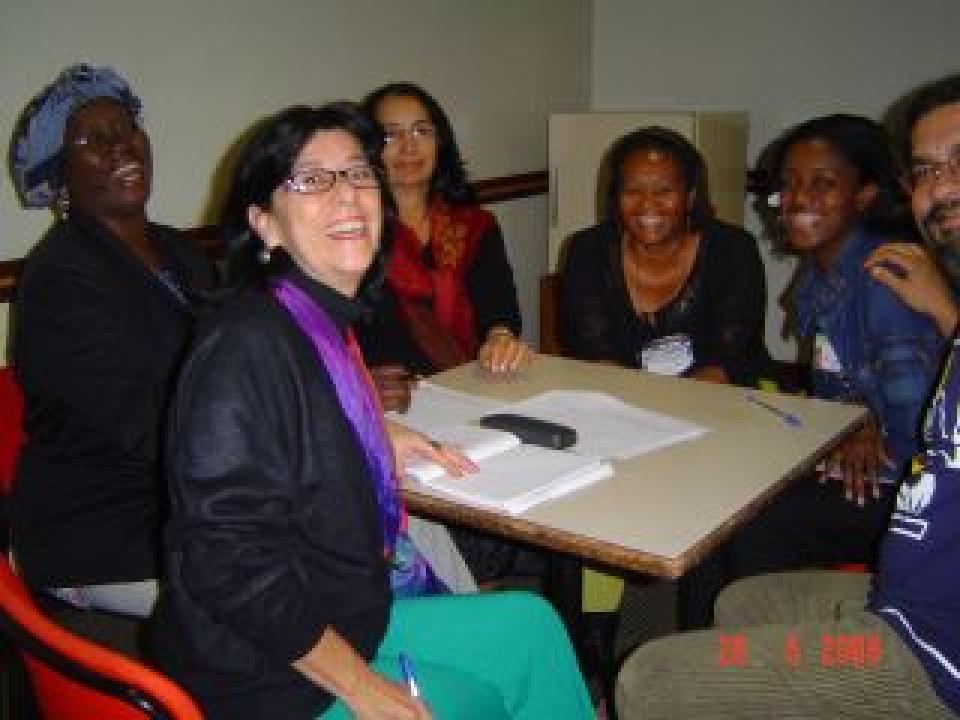
“The use of ICTs encourages and promotes different teaching and learning methods that are proving to be practical, functional, participatory and adaptable”, confirmed Vera Vieira, NGO coordinator.
To expand the process of consideration, training and practice in Information and Communications Technologies (ICTs), the Women’s Education Network in partnership with the regional coordination for Latin American and the Caribbean of the Women’s Networking Support Programme of the Association for Progressive communications (APC/PARM) ran the Advanced Workshop on Gender Equality via the Internet: Application of the GEM/ICT tool (Gender Evaluation Methodology for New Information and Communications Technologies) in Sao Paulo (Brazil) on May 20 and 21. It counted on the support of the international agencies World Association for Christian Communication (WACC) and Novib.
With the workshop, the Women’s Education Network had the objective of providing continuity for its already developed activities within the framework of its Edu-communication Programme, which works on the direct inter-relation between education and communication to advance equal relations and social justice in a globalised world. The work, carried out during the annual NGO (non-governmental organisation) meeting was also a result of the significant increase in the number of RME educator associates since mid-2005, and the need to discuss the theme with these new members. Responsible for the whole process of construction, realisation and coordination of the meeting were the executive coordinator of the Women’s Education Network and institutional representative to APC/PARM, Vera Vieira, and the Argentinean Dafne Sabanes Plou, regional coordinator for APC/PARM – both journalists and social communicators.
Around 40 RME educators, including a social educator and invited persons, took part in the two days of activities. APC, through PARM, is the author of the GEM tool. GEM is the methodology that evaluates ICT projects from a gender perspective, also through which the workshop was carried out. In this sense, Dafne emphasised that the objective of the debates was also to encourage a higher level of ICT appropriation in the daily life of RME; in its communications, work and interchanges, creating space for knowledge, innovations and technological tools to facilitate the task of communication.
A question of gender?
With a Masters degree in the inter-relation of education and communication (USP/ECA), Vera, who is dedicated to the theme of gender and ICTs, considers ICTs, amongst other things, as important in education initiatives and projects for women from communities with low literacy levels. “The use of ICTs encourages and promotes different models of teaching and learning that are proving to be practical, functional, participatory and adaptable.” However, as was also observed during workshop discussions, women are those with difficulties in accessing acquisition and learning of these new technologies which seem to have emerged, only to be used by men. Apart from this, the few professional women in the field of information technology are viewed with prejudice as this is considered to be ‘men’s’ work. Also, as emphasised by Vera, even the “gender” of new technologies is basically masculine. “The design of ICTs was thought out by men, and most of its tools are “masculine”: the computer, keyboard, hard drive, programme, CD, diskette…. It is striking! This is gender prejudice.”
Learning and analysing ICTs
The two days of activities led to many commentaries, reflections and even the unexpected creation of musical initiatives that made references to women and ICTs. The coordinators of the process presented all the details on the use of the GEM tool – made available on the Internet in 2001 by APC and updated in 2006 – which is structured in seven steps. Each step suggests reading, gives examples and proposes activities and timesheets. They are grouped into three phases:
Phase 1: Integration of gender analysis, composed of steps 1 to 4;
Phase 2: Examination of information using gender and ICT indicators, steps 5 to 6;
Phase 3: Put into practice the results of the evaluation, composed of step 7.
“ICTs are not a panacea, it is important that they converge with radio and newspapers, so that further democratisation of communication and participation are attained”, Dafne stressed.
Also taking this aspect into consideration, amongst the individual and group activities carried out during the workshop, educators and guests intensely examined and analysed positive and negative aspects of ICTs in the lives of women, and also of society in general, evaluated cases of gender and ICTs, established indicators and related methodologies based on specific cases, as well as proposed a telecentre project. The theme motivated the participants in different ways and also encouraged the growth of the process by different regions in Brazil, where associates/educators of the Women’s Network are found.
Democratisation
In Vera’s opinion, the debates amongst participants emphasised the importance of the use of ICTs in the whole RME, with the aim of democratising power and responsibilities, increase the degree of the sense of belonging, and expand the discussions in search of gender equality; “For action in society, the importance of ICTs was seen in expanding RME’s proposal, and in women’s and feminists’ movements towards a heterogeneous public, that is “outside the ghetto”. In the same way, the integration of women from rural areas with women from urban areas was considered by Dafne to be very important because of its proximity to ICT themes; “In all of them, there was an obvious interest in understanding these new communication tools, their logic and modalities without, however, allowing themselves to think with the gender perspective about issues that include the relationship between women and technology.”
Multiply and transform
For RME’s executive coordinator, amongst the most important results of the workshop was the participants’ assumption of the technological revolution theme as something irreversible. This makes ICTs in the transformation of social gender relations something above and beyond their function as instruments. “There was also the understanding that ICTs are not neutral in terms of gender, as much in their design – creation, development and implementation – as in their access and use,” she evaluated.
“I believe that women have become aware that it is important to surround themselves with technology, knowing they have all the necessary potential and resources to appropriate and make good use of it, as much for their personal development as for the development of organisations or movements in which they participate” emphasised Dafne. According to the regional coordinator of PARM/APC, the participants had concrete results for the internal operation of the Women’s Network, whose communication dynamics benefited from the work done during the workshop. Moreover, according to Vera, the participants clearly saw that all forms of technological development in transmitting information and knowledge involve inclusion and exclusion; “I think that this latter was the most important point, with the deeper participation of everybody, including the detection of all infra-structural and educational requirements for digital inclusion.”
ICTs under debate
Workshop participants examined and evaluated ICTs. Some of the main aspects of the debate are as below:
Positive: They are rapid, facilitate communication, interchanges and interaction, access to information and knowledge, and promote real-time communication without borders.
Negative: High prices make access to these technologies difficult; they cause health problems, such as repetitive stress injuries; they give excessive information and also fragmented information; they deepen social exclusion; isolate people, violate human rights.
Expectations: Know how to work through digital inclusion, especially of women; to empower women, make decentralised management viable; promote access in poor regions; expand knowledge.
Responses to this post
In the name of god
Dear admnistrator
According to my experience with women isses,more than fifteen years.I have divided
the sterategic goals into the three following levels:
1-political aspects of ICT for women.
2-cultural aspects.
3-economical aspects.
Political:Decisions at the strategic steps(including individual,family based and societal)
Cultural: Educational background,and ethical aspects based on the following views of
every woman(level of motivation,thinking,and emplimentation of ICT.
Economic:It contains thelevel of access to IT,which may be divided to developmental,
macro,and micro level of access.
Apart from the aboved mention levels,another criteria is also into the consideration.
I mean producing(which is along with developmet level) ,planning the software (which is
along with macro level),and finally consumeration (whic is related to the micro level)
To me,being a consumer and use ICT is not acceptable for educated women. They ca
innovate new programs based on their ethics,clture,and so on.
with warm regards
p.faselian
univ.prof.
interested in women isses at the national inter-national and global level
2-
Dear participants:
To me, Fazelina, a unuversity prof., The application of ICT,is related to the basic foundation of the phylosofical views in education. There for the basic foundation of it is related to the educational philosophy of either western or Islamic societies. At the present yime we need to revise our foundations just for the better usage of new devices.
- Add new comment
- 8975 views






Add new comment